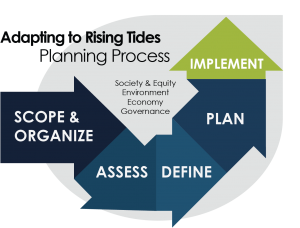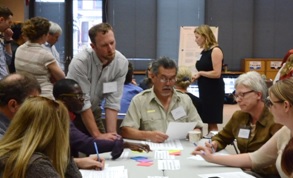The ART approach was built on a traditional planning process framework – from scoping to implementation – that ART Program staff tested and refined to address the specific challenges of building climate resilience across different communities, assets and services, and jurisdictions and owners.
Three factors for success
Experience with a variety of adaptation planning efforts that range from broad to focused scales, single to multi-sector, has led the ART Program to emphasize three factors for success in this approach.
- Collaborative by design Climate change, similar to hazard planning, requires planning across jurisdictions, geographies, sectors, and time frames to address complex, cross-cutting issues. ART emphasizes convening and closely collaborating throughout a planning process with a stakeholder working group representing the diverse values, viewpoints and responsibilities relevant to the project, to build relationships that lead to future collaborations.
- A transparent process To build a strong, actionable case for adaptation, the ART approach adheres to transparent decision-making throughout the planning process. ART Design Your Project guidance and supplies help maintain transparency and support clear communication to stakeholders about decisions and project outcomes, including resilience goals developed and agreed upon by the working group, and evaluation criteria that clearly reflect priorities and objectives.
- Sustainability from start to finish A core aspect of ART is consideration of the relevance and implications of all aspects of sustainability in each step of the planning process, from who is included in the initial working group list to what evaluation criteria are selected to evaluate adaptation responses. ART uses four sustainability frames:
Demonstrated outcomes
Outcomes from past and ongoing ART projects illustrate benefits of this approach to adaptation planning.
- Stakeholders with diverse perspectives and expertise develop a shared understanding of issues, and buy-in for collaborative problem solving, while also building their capacity to independently address climate change issues.
- Time and resources are saved by approaching the analysis of climate impacts exposure in a step-wise manner.
- Using the ART Assessment Questions guides projects through a robust and transparent assessment that takes into consideration all aspects of sustainability.
- Outcomes are summarized from the assessment findings and developed into materials that clearly communicate planning issues and identify actionable next steps for a wide variety of audiences.
- A clear road map for taking action on planning issues is established by collaboratively developing adaptation responses with actions as well as implementation options that set the stage for working group members to launch new efforts and collaborations that have a “life of their own.”
Learn more
ART Approach Handout ![]() and White Paper
and White Paper ![]()
ART Good Planning Guide: Stakeholder Engagement ![]()
ART Good Planning Guide: Transparent Decision-Making ![]()
Definitions and answers to FAQs
ART Portfolio: How-To > Design Your Project
ART Portfolio: How-To > ART Supplies



